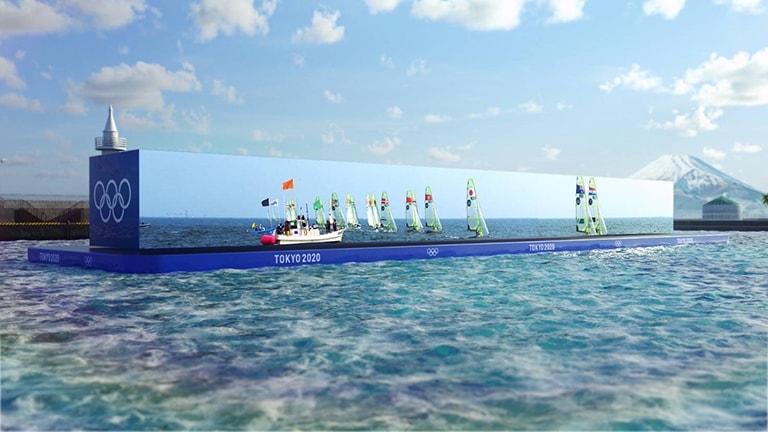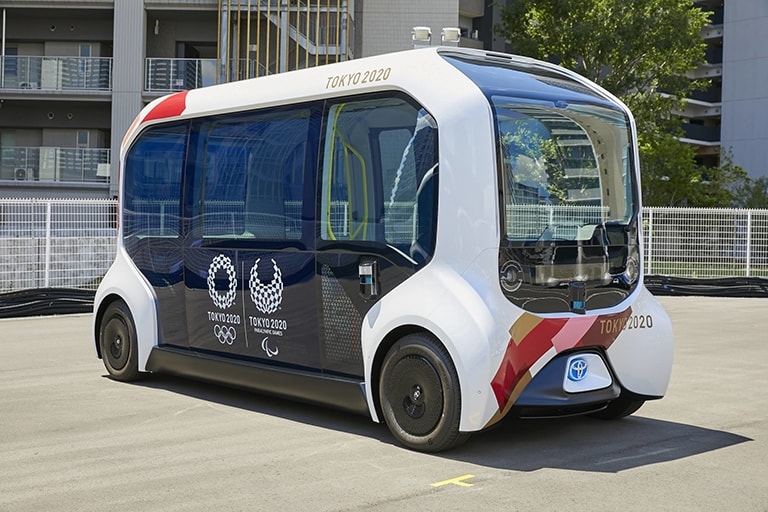Also, these Games may be a catalyst for wider use of augmented reality and virtual reality technology.
NTT has unveiled special goggles that allow spectators watching swimming events to view AR-based information such as athlete profiles and times overlaid on the competition in front of them.
Facial recognition is a promising avenue as well, with NEC Corp. developing a system that can control the entry and exit of athletes and officials from competition venues by instantly reading their faces and the registration cards on their chests.
In the mobility sector, there are high expectations for the automated driving technology unveiled by Toyota Motor Corp.
Japan’s biggest automaker has offered its e-Palette, a self-driving electric bus, to transport Olympic officials around venues.
Drones were used to re-create the checkered emblem of Tokyo 2020 in the night sky at the Games’ opening ceremony, but drones actually made a spectacular appearance during the opening ceremony of the Pyeongchang Winter Olympics in 2018, so let’s not forget to give credit to South Korea.
Other technologies in the spotlight include those with artificial intelligence, such as Fujitsu Ltd.’s gymnastics scoring system, which uses AI and 3D laser light to help judges rate gymnasts’ performances. And 4K/8K broadcasting technologies have helped TV viewers watch the Olympic Games in ultrahigh definition.

NTT and its group firms have developed a viewing system for sailing using drones and boats equipped with cameras to stream videos through ultrafast 5G networks. | COURTESY OF TOKYO 2020
Historically, various technologies have received a boost after they were showcased at past Olympics.
In particular, the 1996 Atlanta Olympics had a great significance from the perspective of digital technology. Until then, televisions had been the dominant means of transmitting information, but the Atlanta Olympics became the first Games to utilize the internet.
At this event, Intel Corp. announced a technology called Intercast, which allowed users to see TV broadcasts and information from the internet together by inserting a TV tuner board into a PC. This was the start of the “convergence of communications and broadcasting” that later became a hot topic in Japan as well.
In order to encourage such technological innovation, the U.S. government also amended the Communications Act of 1934 that year to allow both communications operators and broadcasters to enter into each other’s market. It encouraged NBC, a major U.S. broadcasting company, and Microsoft Corp. to jointly establish the news broadcaster MSNBC in 1996 to cover the Atlanta Olympics.
Visa Inc., a major U.S. credit card company, also rolled out “Visa Cash,” an IC chip-equipped electronic money system in Atlanta. It allowed people to ride trains and purchase items without using cash. The introduction of Edy, an electronic money system developed by Sony Corp., and Suica, an electronic transit card by East Japan Railway Co., soon followed in Japan.
In terms of how the Olympics have stimulated technological innovation in the digital field, the 2012 London Games should not be overlooked. This was the first Olympics to be held after smartphones became widely popular around the world. As spectators came to the Olympic venues with their mobile devices, they were able to watch the Games while viewing other events on their smartphones.
For the London Olympics, telecoms provider BT Group PLC and public broadcaster BBC joined forces to provide a streaming service for the Games. This made it possible for people to watch events that were not aired on TV.
It can be said that the success of the streaming distribution business of U.S. companies such as YouTube and Netflix began with the London Olympics.
BBC also filmed the opening and closing ceremonies as well as the major competitions using 3D technology and broadcast them to the world for the first time in that format. In Japan, since NHK’s priority at that time was developing 8K broadcasting technology, Japanese viewers were unable to watch in 3D, but BBC’s attempt helped spread 3D viewing overseas.
In any case, as the Olympics attract a huge amount of attention from around the world, the event will continue to be a powerful incubator for new digital technologies.
Since Japan’s reputation as a technological powerhouse seems to be waning, I hope that these Olympics, which are being held in Tokyo for the first time in 57 years, will demonstrate the technological capabilities that Japan possesses and make the nation’s presence known to the world once again.

